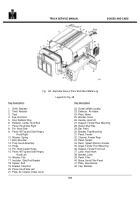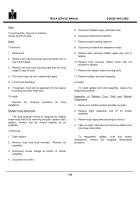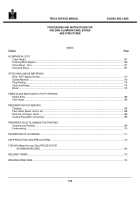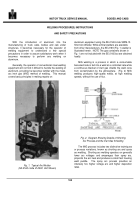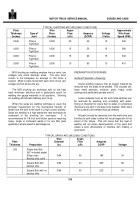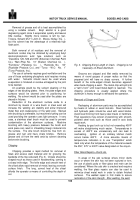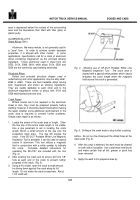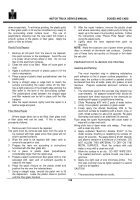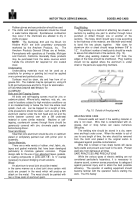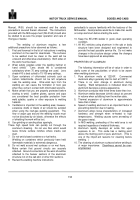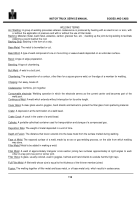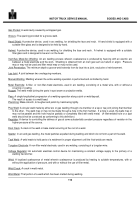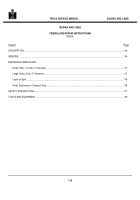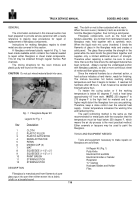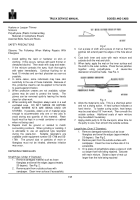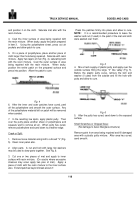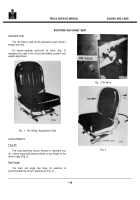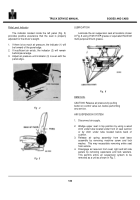TM-5-3805-254-14-P-2 - Page 113 of 894
MOTOR TRUCK SERVICE MANUAL
BODIES AND CABS
Manual, IR-50, should be reviewed and the safety
precautions covered therein observed.
The instructions
provided with the MIG equip-ment (SE-2165) should also
be studied to as-sure the proper operation and care of
this type of welder.
The welding of aluminum requires a few
additional precautions to be observed as follows:
1.
First and foremost in the list of instructions in welding
aluminum is the need for cleanliness.
The surfaces
to be welded must be clean or the weld will be
unsound and otherwise unsatisfactory.
Both sides of
the work must be clean.
2.
Wear safety goggles under the welding helmet or
hand shield.
Lens shade #8 is considered
satisfactory when 75 amp settings are used.
Lens
shade #10 is best suited to 75-100 amp settings.
3.
Open containers of chlorinated solvents such as
carbon tetrachloride should not be left anywhere
near the welding area.
Ultra-violet rays from the
welding arc can cause the formation of toxic gas
when they come in contact with chlorinated solvents.
4.
Make certain that you are properly protected before
starting to weld.
Leather gloves, aprons and caps
are considered the best possible protection from
weld splatter, sparks or other exposure to welding
hazards.
5.
Ventilation is important in the welding area; however,
excessive drafts or blasts of air should be avoided
when using the inert-gas welding equipment.
The
flow of argon gas around the welding nozzle must
not be disturbed by air blasts, otherwise the effects
of shielding the work will be lost.
6.
Use grinding or sanding discs sparingly.
These high speed tools can quickly cut through the
aluminum sheeting.
Do not use files which would
leave minute surface notches where cracks can
start.
7.
Do not weld closed containers or fuel tanks.
Welding on containers which previously have held
flammable materials is extremely dangerous.
8.
Do not weld around wet surfaces or on wet floors.
Make certain that ground circuits are securely
attached.
Ground connections at the work should be
attached to the heavier sections of the aluminum
structure not on the cab skin or other thin sections.
9.
Review the welding machine instructions
periodically to assure familiarity with the features of the
MIG welder.
Good practice would be to make trial. welds
on scrap aluminum before starting the work.
10. Keep the SE-2165 welder in good, clean operating
condition.
11. All IHC vehicles using aluminum in the cab or body
structure have been designed and engineered to
provide the best possible service life.
Do not make
changes in the structure design unless the changes
have been approved as acceptable.
PROPERTIES OF ALUMINUM
The following information will be of value in order to
clarify some of the peculiarities of which to be aware
when welding aluminum:
1.
Pure aluminum melts at 12200F.
Commercial
aluminum alloys generally start to melt at 1050°F.
2.
There is no color change in aluminum during
heating.
Weld temperature is indicated when the
aluminum develops a glossy appearance.
3.
Aluminum conducts heat three times faster than iron.
4.
Aluminum welds decrease (shrink) about six percent
in volume when solidifying from the molten state.
5.
Thermal expansion of aluminum is approximately
twice that of steel.
6.
Speed of welding aluminum is an important factor in
preventing distortion due to heating.
7.
Aluminum alloys loose characteristics of increased
hardness and strength when re-heated to high
temperatures.
Welding causes some annealing of
the parent metal.
8.
In MIG welding, preheating of the weld area is not
required regardless of material thickness.
9.
Aluminum rapidly develops air oxide film upon
exposure to air.
This oxide has a melting point
above the melting point of pure aluminum.
(This is
one of the import-ant reasons for cleaning before
welding.
)
10. The cleaning of aluminum surfaces before welding is
of major importance.
Cleanliness cannot be over-
emphasized.
111
Back to Top

